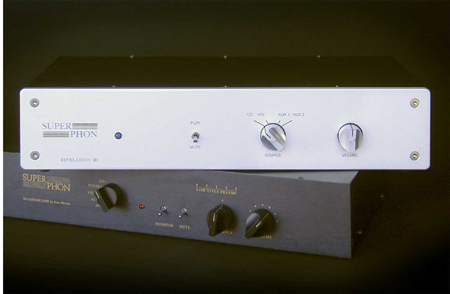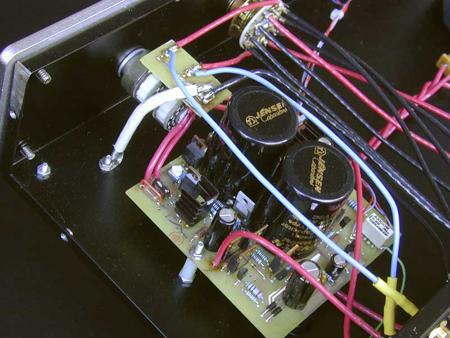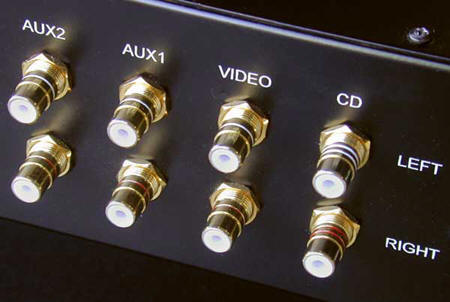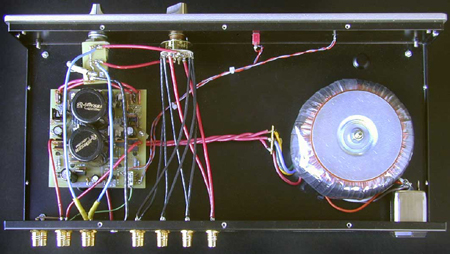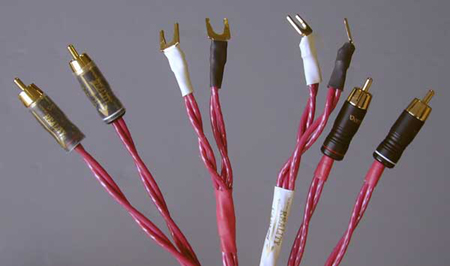|
You are reading the older HTML site
Positive Feedback
ISSUE
23
No Gain, No Pain - The Superphon Revelation III
preamplifier and Reality Cables
Ever happen to you? Old friends divorce, business partners split, your Saturday morning threesome breaks up. You move on, life as usual, and then one day run in to half of a once indivisible pair. Is it not guaranteed that the other party will also return to your orbit sooner than later? So it was that, having completed a review of the PS Audio GCC 100 Control Amplifier for this fine enterprise, I headed up to Denver and the Rocky Mountain Audio Fest. I half expected to run into Paul McGowan there (he being the P in the "initial" PS Audio) as they are corporately located below the front range. But no. Instead, I wander into a random room and do a double take: a preamp that looked damn like the old Superphon SP100 that has long been relegated to second-system duty since I acquired my Herron Audio tube gear. Superphon was the concern that Paul's ex-partner Stan Warren started after leaving PS Audio, and a marquee that earned a well-deserved reputation for high value/high performance preamps back in the day. Guess what? He's ba-a-a-a-ck. OK, so Stan wasn't actually there, but business partner Chuck Jones was ably manning the fort along with Gregg Straley of Reality Cables. Once the déjà vu dissipated, it quickly became audibly obvious that, whatever the outward similarities, the new pre was like an old SP100 on Romanowski-level steroids. We chatted a bit, and shortly after the show, UPS dropped one off for review. Now for many audiophiles, preamps are like the overlooked middle child who can never match #1 Son's accomplishments nor compete with baby sister on the adorability index. Ivor Tiefenbrun effectively made the case for the primacy of the source with the LP-12 turntable, but every audio salonista knows its power amps and speakers that draw the big bucks. Glowing tubes, sculptured heat sinks, diamond tweeters, 'stats, subs, and exotic veneers are highly marketable fetish objects. Face it: most preamps are functional and b-o-r-i-n-g. In fact, at least since the advent of the CD, they have tried to eliminate the damned things entirely. Vintage preamps had a lot to do: equalize and amplify the disparate outputs of multiple sources to a given level, and then attenuate (and modify as desired) the output to the power amplifier. They therefore came fully adorned with numerous knobs, levers, and switches. Look at 1950's era preamps and you find multiple-choice EQ settings for the built-in phono stage, inputs for tape recorder heads as well as tuners, recording in/out loops for multiple tape decks or external processors, headphone jacks, mono/stereo switches, balance and tone controls, loudness compensation and treble/rumble/noise filters, but hey—not remote a remote in sight. Come the 1980s, Perfect Sound Forever obviously was not, and the preamps of the day sure seemed among the likely culprits. All those circuit options mucking up the purity of the signal, we presumed. Simpler, less complex preamps soon came to market. As Red Book replay specified a line level output, the "line stage" without phono capability was thus born for those who scornfully traded in their LP collections (and inevitably, came next the freestanding phono stage for those who had an acquired taste for licorice pizza). The flexibility of the earlier preamps simply disappeared from the fascia—switch by switch, knob by knob. A lot of that was promptly replaced by trick cables and room treatment gear, and of course, damn the cost. Superphon and Stan Warren were early exemplars of the minimalist trend, notably with the Revelation Basic and Revelation II preamps. These were bare bones dual-mono budget-priced boxes (with phono) that handily outperformed much of the high end's expensive spread. Of course, even the simplest of conventional preamps had a gain stage (or two) before the attenuator. On the other hand, the standard CD player output voltage was high enough (~2V.) that there was putatively no need for any additional gain. If simpler sounded better, would not eliminating the preamp be better still? Some CD players had variable-level outputs, so audiophiles tried driving the power amp directly; alas, most players sounded worse that way—the output stages were not up to the task. The solution next seemed to be high quality outboard passive attenuators. The Brits raved about the Audio Synthesis Passion; EVS, The Mod Squad (later McCormack) and Reference Line had similar followings in the US, and the DIY crowd soldered up resistors by the dozens for stepped attenuators. While these simple devices eliminated the active circuitry, the audibly increased transparency was often compromised by a lack of dynamic drive, bandwidth truncation, and increased distortion from some source components. The problems turned out to be largely the impedance mismatches between source, passive unit, and power amp. Superphon had addressed these issues with the curiously named CD-MAXX, an outgrowth of the Revelation II (minus the phono stage), in a nonmagnetic acrylic and wood chassis. It featured shunt regulation and Class A mosfet outputs at a budget price. Uniquely, it could be used in either active or passive mode. All this was also being played out in print. Stereophile was a much livelier read in those days, notably for the contributions of the obstreperous and scatologically obsessed Corey Greenberg (who eventually cleaned up his act enough to end up the home electronics demo guy for the Today show). Greenberg touted the superiority of his simple DIY buffered passive preamp (based on the BUF-03 op-amp from Analog Devices) to both active and passive commercial preamplifiers–the idea was to provide optimum impedance matching and adequate drive. My Superphon S (for Signature) P100 is circa 1991, and was the first buffered passive preamp to be marketed commercially. It was a zero gain, zero feedback, direct-coupled, high slew rate impedance converter, and input selector with a decent quality stereo pot. I used it mostly with a modified NYAL Super-It tube phono stage as well as several forgettable CD players, as it was better than the Super-It used direct with it's own controls. I sent it to Stan Warren for a minor upgrade once, and it served me well as the control center for a second system in my studio for years. Like the early Revelations and the CD-MAXX, it retains a bit of cult status on the used market even today. The revitalized Superphon's latest effort reverts to the higher name-recognition Revelation designation (as the model III), but in concept and cosmetics it seems more like a refinement and extension of the SP100. In preparing for the review, I asked Stan Warren about this, and he provided the following explanation: "The SP100 was born out of the fact that its predecessor, the CD-MAXX, was a passive/active unit with a line stage good enough to leave in the signal path. This was 1990. People kept asking if we could reduce the gain so they could leave it in active mode without such high volume control sensitivity. Sometimes when the writing forms on the wall, you should read it! We do not need gain, but do like drive and frequency extremes. Therefore, I designed a simple buffer with shunt regulation and passive switching and volume controls. The SP100 tests as good as or better than the Rev III tests, but does not have the sound quality. The 100 is a symmetrical complementary circuit with high AB biasing made with bipolar transistors. The Rev III is a high bias, single ended class A circuit made with cascode current source loaded mosfets.
"There are only five parts in the series signal path. The power supply is heroic by any standard, and the regulation is current source fed mosfet shunt. The parts and wiring are the best I could find after much testing and listening. The input resistance is 10kOhms and the output is about 40 Ohms. The auto or manual mute is a grounding type so the relay is not in the path. The unit is so simple that there is only a single operating instruction page. We will probably flesh that out soon, as it appears people want to read something!" Well. I suppose that is why we are here right now, are we not—kindly read on. What else has changed? The SP100 retailed for around $400 15 years ago, and Warren's earlier designs were similarly budget based, and looked it. The Rev III has a MSRP of $2199, so there should be more than inflation at work, even if today's price is still "affordable" by high-end standards. For starters, the SP100 weighs less than 7 lb.; the Rev III comes in at a hunky 16 lb. What is also obvious from the outside is the improved casework—1/4" thick faceplate (brushed chrome, but black should be available in the near future), and an 18 gauge steel chassis. There are even three asymmetrical dimples on the bottom to facilitate cup and ball isolation devices, should you be worried about losing your bearings-or your marbles. The early prototype had dome shaped knobs; the shipping version has knobs that recall those on the SP100. One less knob, though there is no balance control on the Rev III, not even dual monos as on the Rev II. Warren has opted for a stereo stepped attenuator (sourced from DACT) for sonic reasons. No tape loop either, just an output to a silver-contact input selector and a mute switch complete the control array. There is not even a power button, just plug it in and keep it warm—break-in is something like 100 hours. A remote, you ask. From Stan Warren? Are you kidding? If you cannot deal with hairy-shirt audio, go listen elsewhere ...until, that is, the rumored remote driven version sees the light of diode.
'Round back, instead of the captive zip cord AC line of the SP100, we have an IEC socket to allow macho third party AC cords. There are four inputs, all RCA, no balanced. One set (the double striped jacks marked "CD", which I will take issue with below) is Vampire's best direct gold-plate over OFC copper, as are the two pairs of main output RCAs. The other inputs and tape out are gold over brass, but you can up spec them as desired when ordering.
Popping the hood tells the rest of the story—see the pix. That is a 225-watt transformer sharing the space with a circuit board stuffed with quality parts–this is not your grandma's empty box passive pre. Looks like a conventional preamp inside, except there is just no gain stage. Unless your system is way-y-y inefficient, that is, and you really need the optional gain stage afterburner, (I did not audition that version). No component—and especially no preamp—can be evaluated in isolation. The associated equipment in the chain, especially including the cabling, will have an increasing impact on the sound roughly proportionate to the resolution and neutrality of the preamp. The system at the Rocky Mountain Audio Fest demo room had also involved Reimer loudspeakers and Reality Cables, one of approximately 1753 new cable concerns vying for the attention of the anxious audiophile. My interest was piqued when I learned that they had supplied the internal wiring for the Rev III. While there was nothing outwardly special about the Realty Cables (see separate sidebar below), I asked for some interconnects and speaker cables to take advantage of whatever synergy might come from using the same cables used in wiring (and presumably voicing) the preamp. Most of the review sessions were with the Reality Cables running to and from the preamps. As the Reality's are unshielded, I used the excellent Nordost Heimdall interconnect from the Audio Interface step-up transformer to Herron phono stage. I did not get a stock AC cord with the Rev III, so used a JPS Labs power cable throughout the sessions, straight into the wall (my listening room is on it's own circuit). The review unit had been on demo elsewhere, and the Reality Cables come pre-burned-in-at-the-factory, but as Stan Warren recommends 100+ hours. I used the combo for several days for casual listening, subjecting it to plenty of Cosmic Hippo and the like on repeat while I was out. The first impression of Rev III was of remarkable clarity of detail, especially in the HF range. My Amphion Xenon speakers were not shy about revealing this: they are 3-way aluminum driver towers that cross over to the tweeter at 1200Hz, unlike most designs that place the transition at around 3kHz, and consequently the phase, amplitude, and dispersion variations right in the middle of the "detail range". Dead quiet too, was the Rev III, as one might expect. I did my initial trials with SACD recordings, especially the Tilson Thomas Mahler recordings and RCA and Dylan reissues, re-mastered CDs (like the Dire Straits Bothers in Arms and various JVC reissues), and both regular and HDCD discs that I knew pretty well. The disc player was a slightly modified Denon 2910, with all video circuitry disabled. It is hardly state of the art, but I had surely never gotten this level of resolution out of it before. Of course, I wanted to gauge how far Warren had come with the buffered passive idea. The SP100 is one of the rare budget components from the '90s that returns 50% of the original retail on the used market. Good as it is, the Rev III made it sound veiled, slow, and rolled off at the frequency extremes. What may have been suitable for the CDs, cartridges, and speakers of 1990 is not up to snuff today. Still, one could discern the family resemblance in the overall ease of presentation and lack of glare and grain. Next up was a Reference Line 3000 purely passive preamp (from about the same era) that had displaced the SP100 in my main system back when. The RL3000 uses silver/Teflon wire, a single Vishay resistor, and attenuates the signal via a shunt to ground. Interestingly, the RL seems to use the same (or similar) upgraded RCAs as does the Rev III on the CD/Main Out path. The contest here was closer, both units showing remarkable transparency and inner detail. Still, the Rev III did have superior resolution, dynamics, and HF extension—especially evident on SACD. Both the RL 3000 and Rev III also had an edge in resolution and HF extension over my tubed (and quite active) Herron Audio VTSP-1A/166—your classic passive-pre transparency at work. Initially, the Rev III did not compete with the 50% more costly Herron in (OK, tube) warmth, richness of timbre, soundstage depth (width about equal), or musical drama. Much as I appreciated the jaw-dropping crystalline clarity of the Rev III, I was often more caught up in the performance with the Herron. Of course, something like this comes up in just about every tube/solid state comparison, so one must consider the salt grains. My adobe listening room is rather unforgiving, and the Xenon's do have a bit of Scandinavian cool about them, but with digital replay, the Rev III as received had a perceptible tendency to emphasize resolution at the expense of a slight bleaching out of tonal color through the lower midrange/upper bass. Just as I was mulling the above conclusion, the phone rings. Chuck Jones of Superphon wants the unit back. Stan wants to change something minor in the grounding scheme, with a somewhat warmer sound promised as the result. Deal, even if it meant standing in line at the Post Office in the middle of the Christmas rush. You have to love designers who tweak on into the night. So now, on to the Rev III rev. 2. Back in the system, a couple more days to burn in, and indeed, I do like the overall balance better. Not "tube-like", of course, but very listenable, indeed, in the best solid-state fashion of, say, Pass Labs Class A gear. A skosh fuller, richer, without sacrificing detail throughout the range, and while aural memory is suspect, more dimensional too. Take Evelyn Glennie's Light in Darkness on RCA 60557-2, for example, a collection of contemporary works for marimba and percussion. That marimba often spans the expansive soundstage, and the various whacks, dings, clacks and cymbal swooshes are, well, everywhere. Following the cascade of sound as reproduced through the Superphon can actually make you roller coaster woozy, but still wanting more. The Rev III starts and stops on a dime, has tremendous immediacy, and preserves the reverberant field convincingly. The resolution is extraordinary, but never "etched" or grainy. Recordings with a vast soundstage—like many of the RCA SACD reissues or CDs from the much-missed Reference Recordings—conveyed convincing depth as well as breadth. Well-recorded chamber music has extraordinary presence and instrumental textures, and pianos and plucked strings are reproduced with distinct attack, sustain, and decay. Pop music is of course variable. Chesky and Mapleshade stuff is exemplary in replay, as is most of the audiophile canon of small combo female vocals. Mainstream CD issues? Warts and all, all over the place: the Rev III is not remotely euphonic, and the gaps between awful, just OK and really good CDs expand dramatically. Even after the update, there remained a tendency in my system to emphasize slightly the upper midrange that did not compliment "hot" CDs, but this could simply be a problem with the Denon player or elsewhere in the system. Here is where I take issue with the labeling of the "special" gold over copper input as for "CD". In many cases, I preferred digital replay through the "standard" gold over brass RCAs, which being less extended, may let in less "garbage". However, the fact of the matter is you can hear the difference between RCA jacks from the same manufacturer. I bet Stan would even put in a set of WBT Next-Gens if you asked nicely. Perhaps Reality Cables should produce a bi-wire interconnect that will allow switching between inputs on the fly. Enough bitching about the bits. When I plugged the Herron VTPH-1 tube phono stage into the Rev III's high-spec "CD" jacks, I heard very little of the shortcomings noted on digital, and very much of what analog has to offer in the 21st Century. Moreover, I spent far too much time listening to vinyl for the sheer fun of it. For example, the Reiner Scheherazade (LSC2446) and Gibson's Carmen/Faust Suites (LSC2449) in original Shaded Dog vinyl are about as well-recorded classical music as you can find—and whoever was on the mastering console that week was definitely on a roll. Through the Herron/REV III combo, you not only relished the performances, you experienced the differences in the orchestral layout within the vast, and deep soundstage, the recording hall acoustics, and the mic placements of Louis Layton in Chicago and Mr. Wilkinson, I presume, in London. Moreover, the vintage vinyl moved even further ahead of the well-regarded SACDs. I was initially concerned about the lack of a mono switch on the REV III, but the mono image is extremely tight and precisely centered. The amazing clarity of the passive design heightened the detail and drama of Ricci's swagger through Sarasate's Danzas Espanolas (London CM 9090) right down to the rosin-puff level, placing the piano accompaniment well back in the soundstage. Similarly, deep groove mono magic was obvious on The Genius of Charlie Parker (Savoy MG 12014), a 1961 RVG mastering of 40s originals, and Blue Note monos had the requisite bop, bite, and bounce. LPs with well-recorded complex dynamics, like Basie's Benny Carter collection Kansas City Suite (Roulette Birdland SR 52056) were explosive and never compressed or congested, with excellent pace—OK, swing. One evening my fascination with the Rev III's transient response led me to dig out all those silly Dick Shory percussion and Martin Denny Exotica records just for the giggles and the wall-to-wall soundstage. The next night, it was early music on Harmonia Mundi, BIS, and Pierre Verany. Then, the Solti "Ring", LvB and more Mahler power music. The New Grass Revival and Allison Krauss. Waylon and Willie and J. R. Cash. The Roches, the Persuasions, and the Manhattan Transfer. Fast, clean, and in control all around. Yes, this degree of transparency can get you distracted by audiodork issues like VTA fiddlin', resolution at the corners of the soundstage, image height, and how deep the studio fade to zero is—but the Superphon superbly served up all sorts of music. If you have a high-resolution analog front end and phono stage, the Rev III will get all the glory in the groove on its way to the amp intact and uncompromised. A couple of caveats, though. First, if the other elements in the system are not of equivalent quality, the virtues of the Rev III's remarkable transparency will simply be lost. My Michael Yee PA-2 power amp proved an excellent match for the Rev III, sounding better than I ever imagined a $1300 amp could. Modern Class-A and Class-D switching amps should also be natural matches for the new Superphon. On the other hand, my two older amps, a tube-hybrid Precision Fidelity M-8 and a sweet little old 25-wpc push/pull triode showed far less improvement. A check with Gregg Staley of Reality Cables confirmed that I had the solid-state version of his interconnects, and perhaps the tube version would have suited them better. Have to check that out. I thus would not generalize about either SETs or conventional tubes, but I would certainly give it a shot, especially with horns and appropriate cabling. Speakers? Both the $5K Amphion Xenons and the $150 Radio Shack/Linaeum minis were happy campers; some older (cloth dome tweeter) speakers failed to get merit badges. If you have fast panels, ribbons, or any of the newer generation tweeters that occasionally sound a little grungy, consider making a call to Oregon. You probably won't find a Rev III at your local dealer (yet), but you can purchase online through Audiogon (ClearSound Audio, [email protected]) and maybe save a buck or two for some new interconnects. The big worry. The tranny-boosted Herron phono stage drove the system through the Rev III with no problems at all. However, if a recording (like the SFO Mahler 1 SACD) seems mastered at an unusually low level, all the "passives" required setting the attenuator pretty wide open (~3 o'clock) to achieve satisfying levels in my system. Frankly, I tended to listen at higher levels with the Rev III than usual (this according to She Who Must Be Obeyed). I suspect this was because of the glare-free clarity and the utter lack of compression or overload. Obviously, one should consider a passive pre only in the context of the source's output, amplifier sensitivity and power, speaker efficiency, room size, etc. Howdyadodat? Choose a disc that you know requires a bit of level goosing, and plug the CD player directly into the power amp. Push PLAY. The suitability of a passive preamp in your system is directly proportional to the urgency with which you hit STOP. Do not try this with VTL Wotans and Lowthers, however… While I never "ran out of steam" with my 100-wpc Michael Yee amp and the 87dB Amphions, by definition, the Superphon cannot be turned up to 11. Sorry, Spinal Tap wannabees, but passive preamps are not for Headbangers. If you actually listen like a neurosurgeon, though, the Rev III can truly be a revelation. Properly connected to quality components, it will make most active preamps sound like bottlenecks (and no slight to tube guys intended). The idea of a buffered passive preamplifier was a pretty good one fifteen years ago. The Superphon Revelation III demonstrates what can happen when a designer as talented as Stan Warren takes the time to refine that simple idea into an exceptional product that redefines a whole category.
Superphon Inc.
The Reality Cables The Reality Cables were a distinct surprise. Distinct, in that the interconnects ($225 per 3' pair) equaled or bettered every other cable I had on hand in terms of staging, resolution and HF extension, up to and including the Nordost Heimdall with the trendy WBT Next-Gen RCAs. Oddly, they are just about the same magenta color, and just about as uncolored as the famous-name brand. Surprising, because they appear to be a simple twisted pair with generic plugs, and are, like, a third the cost. Gregg Straley of Reality Cables seems like your basic demon audiophile with a day job, and is hardly the first to market a "home-brew" cable design. While Circuit City sells miles of Monster, it's mild-mannered fanatics like Straley who come up with the interesting alternatives. He keeps a few secrets to himself, but lets it be known that the bulk wire he uses was originally designed for a non-audio application, and that he finds it audibly superior to the oft-touted 6-nines and single crystal copper used by many cable firms. Each "wire" is basically an unshielded spiral bundle of what looks like eight rather large copper "strands" (each maybe 24 gauge) that is double-cryo-treated. I have no idea as to the tight, thin plastic dielectric material's composition. The plugs supplied were Vampire OFC copper. There are actually different interconnect designs for tube amps versus solid-state systems—as noted in the Superphon review, I had the solid-state version only. For all that, this is quite low on the snake-oil ratio as start-up cable companies go. First, understand that this is not intended to be a proper cable review, as wires are notoriously system-dependent, and I don't have the patience to do extended multi-product cable shoot-outs. Although cables are crucial to any high performance system, in my experience the ear/brain system readily accommodates differences in presentation as normative. In other words, what one considers "neutral" is subjective and learned. Hence the sound of your friend's system which you find intolerable, and vice versa. In addition, why the audio cable industry is so trendy—and designs so diverse. As I imply in my review of the Rev III, when preamps lost tone controls and filters, specialty cables came to function as their expensive replacement. For many cable designs, timbre is the most salient (and salable) characteristic–brighter, richer, deeper, etc. Apply as needed to tame the problem component. Unfortunately, as cables are passive devices, departure from neutrality really means loss of information: one hears only what gets through. Sure, the Reality Cables ICs sounded "neutral" in my system in that changing components changed the tonality in appropriate ways: tube amps sounded warmer, solid state leaner, for example. What I liked about the Reality Cables/Rev III combination was how dramatically they demonstrated the difference between neutrality and transparency: one suddenly hears how much gets through. Detail galore across the audio range, excellent imaging, and plenty of "air" at the top. Therefore, there may indeed be a certain synergy here with the internal wiring of the Rev III, but I suspect it is also a matter of the cable's frequency extension and behavior in the time domain. These cables are "fast" and detailed without being silver, shielded, thin, fat, flat, or suspended in air, ozone, or ostrich snot. Go figger. On the other hand, much of this detail was lost when the Reality Cable interconnects were used with less transparent preamps, even the otherwise excellent Reference Line passive and Herron tubed units, or with amps that just could not get up to speed. Likewise, it is a no go if less capable cabling is in the chain. Information lost cannot be regained. Period. Thus our quandary. In the right context (i.e., flanking the Superphon) the Reality Cables interconnects were close enough to the excellent $600/M Nordost Heimdall in overall presentation that there was little to quibble over—and both outperformed the other cables I had on hand. In lesser environments, each cable had pluses and minuses, but the limitations seemed as much the componentry as the cables themselves, and there was a clear regression towards the mean. In other words, your mileage may vary. Fortunately, the Reality Cables are sold direct, pre-burned in, and with a 20-day return privilege. If your system has the resolution headroom, and your budget is bang-for-buck driven, put them on your shortlist. I was somewhat less persuaded by the speaker cables ($225 for 8' pair), which are just a doubled run of the interconnect: same conductors, tightly spiraled, supplied with spades. The result is a significantly stiffer cable that can pull an un-blutak-ed mini-monitor off a stand if you are not careful. The speaker cable clearly complements and conveys the extended bandwidth and dimensionality of the interconnects. In comparison with other speaker cables, however, I thought both the Nordost Red Dawn II (bi-wired with Z-plugs) and the Eichmann Express 6 Series II (with their novel "bayonet" banana plugs) a bit more dramatic than the Reality Cable in my system. The Reality's were a bit smoother than either of the others (which may be saying the same thing), and about as quick as but less colored than the Nordost. Again, these are well-regarded and more expensive alternatives, and I did not have the bi-wire option with the Reality's. You can spend a ton of money on heavily advertised cables and not get nearly the level of musical information the Reality Cables convey. There is an intuitive as well as technical logic to maintaining a coherent cable voicing throughout a system, and the Reality Cables/Superphon approach successfully employs the identical basic conductor from source to speaker. Neat, indeed.
Reality Cables
|

